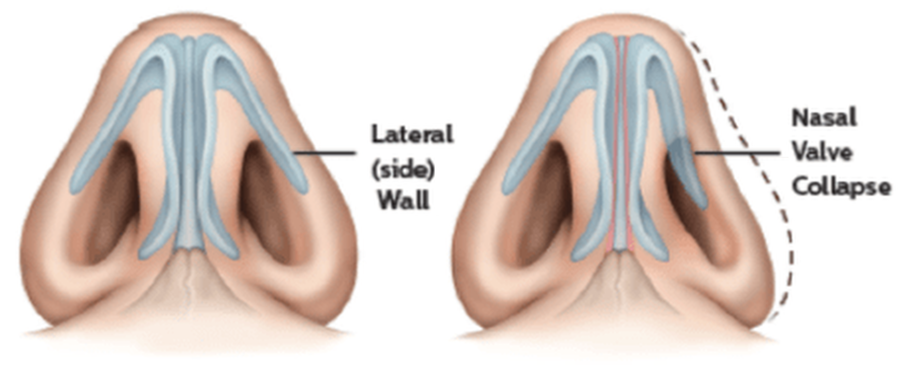Learn About Diagnosis, Obstruction, and Treatment Options
Ever Feel Like You Have a Clothespin on Your Nose?

More than 20 million Americans have obstructed nasal breathing that places real limitations on their quality of life. 1About 70% of the airflow to your lungs comes through your nose, 2so it’s no wonder a nasal obstruction would compromise your ability to breathe.3
Nasal airway obstructions cause symptoms like 4:
- Nasal congestion or stuffiness
- Feelings of nasal blockage or obstruction
- Problems breathing through your nose
- Sleep disturbances
- Inability to inhale enough air through your nose during physical exertion
Just inside your nose is an area called the nasal valve. It’s comprised of three main structures of tissue, cartilage and bone. One of these structures is the cartilage in the lateral (side) wall of your nose which normally resists the pressure of airflow as you breathe in. If this cartilage is inadequate or weak, it will allow your nasal wall to cave in as you inhale, which significantly reduces the airflow into your nose.5,6,7 This condition is called Nasal Valve Collapse and is considered one of the main causes of nasal airway obstruction.8,9
Southern Indiana ENT Sinus & Allergy provides comprehensive treatment for nasal valve collapse. Our team of doctors and specialists is highly trained in diagnosing and treating this condition, ensuring the best possible outcomes for our patients. Nasal valve collapse occurs when the nose walls weaken or become blocked, decreasing airflow through the nostrils. We offer various treatment options for nasal valve collapse that may depend on the severity of symptoms and the details of each person’s unique anatomy. Our team is dedicated to helping you find the treatment option that best meets your needs and goals. With our expertise and dedication, we are here to help you find relief from your symptoms so you can enjoy life again!
What Is Nasal Obstruction?
Nasal obstruction is a medical condition in which the nasal passages become blocked due to swelling or narrowing of the nasal cavities. Various factors, including allergies, infections, and physical obstructions such as a deviated septum or enlarged adenoids can cause this. Nasal obstruction can lead to difficulty breathing through the nose, snoring, poor sleep quality, and other uncomfortable symptoms. Southern Indiana ENT Sinus & Allergy has doctors and specialists trained in diagnosing and treating nasal obstruction to help you find relief from your symptoms.
Causes of Nasal Obstruction
There are many potential causes of nasal obstruction. Allergies or respiratory infections can cause the nose to swell, resulting in difficulty breathing through the nostrils. Other possible causes include physical obstructions such as a deviated septum, scar tissue, age-related atrophy of nasal tissue, enlarged adenoids, or a nasal valve collapse, which can block airflow and cause symptoms of nasal obstruction. Certain medical conditions, such as cystic fibrosis or chronic sinusitis, may also contribute to obstruction. To determine what is causing your nasal obstruction, it is crucial to work with an experienced doctor who can provide a thorough diagnosis and recommend the best treatment plan.
What Is Nasal Valve Collapse?

Nasal valve collapse is a condition where the walls of the nose collapse, causing a narrowing of the nasal passageway. This narrowing can lead to a nasal obstruction, which can cause difficulty breathing and other symptoms. At Southern Indiana ENT Sinus & Allergy, our team of experts can diagnose and treat patients suffering from this condition.
Diagnosis and Symptoms of Nasal Valve Collapse
Southern Indiana ENT Sinus & Allergy uses advanced imaging techniques and procedures to diagnose nasal valve collapse. Common symptoms of this condition include difficulty breathing, a feeling of congestion, snoring, nasal passages closing when breathing in, and a whistling sound when breathing. If you are experiencing any of these symptoms, our team can provide you with an accurate diagnosis and treatment plan. Contact us today to schedule an appointment and begin the journey to relief from your nasal valve collapse symptoms.
Treatment Options for Nasal Valve Collapse
At Southern Indiana ENT Sinus & Allergy, we offer a variety of treatment options for nasal valve collapse. The severity of your symptoms and the degree of obstruction will determine the type of treatment options your ENT specialist will recommend. Here are a few treatment options that may be presented to you if you suffer from nasal valve collapse symptoms:
- LATERA (Absorbable Nasal Valve Implant) – An implantable medical device made of biodegradable material that provides permanent support to keep the passageway open, relieving congestion and improving breathing.
- Cartilage Grafts – A surgical procedure that can help to reconstruct or strengthen the nasal passages using cartilage taken from your body.
- Nasal Bridge Broadening – A surgical procedure that can increase the size of the passageway between nostrils for improved airflow, helping to reduce blocked airways.
- Permanent Sutures – Durable, long-lasting absorbable sutures sometimes used during surgical procedures to aid in structural and tissue integrity.
- Endoscopic Sinus Surgery – A surgical procedure involving an endoscope to visualize the different structures of the nose and aid in modifying nasal structures and tissues to increase airflow.
- Septoplasty – A surgical procedure to correct any malformations of the septum, which is the middle structure dividing the nose into two passageways.
- Turbinate Reduction or Excision – Turbinates are mucus-lined structures found in the back of the nasal cavity that aid in humidifying the air we breathe. Sometimes they become enlarged, causing nasal airway obstruction. Removing or reducing them helps to achieve better airflow.
Our team of experts can help you find the best treatment for your condition and provide the care and support you need to get back to breathing normally. Schedule an appointment today to get started.
LATERA® Absorbable Nasal Implant
The LATERA® Absorbable Nasal Implant is a revolutionary medical device designed to help relieve nasal airway obstruction in patients suffering from nasal valve collapse. Made of biodegradable material, the implant is placed in the nostril and is a permanent support for the passageway, helping keep it open and allowing for improved airflow. This minimally-invasive procedure offers long-term results with minimal downtime while relieving blocked airways and improving breathing. It is ideal for those seeking effective, lasting relief from their symptoms without undergoing major surgery. Our Southern Indiana ENT Sinus & Allergy team can provide you with more information about this treatment option during your consultation.
- Satisfied with their breathing after the procedure – less nasal stuffiness and blockage, fewer problems breathing through their nose
- Satisfied with their appearance after the procedure – no long-term adverse cosmetic changes after receiving the LATERA implant
- Satisfaction overall with the procedure – sleeping better, breathing better during activities and physical exertion
While individual results may vary, clinical research11 with LATERA® demonstrates significant improvement in Quality of Life for patients with Nasal Valve Collapse.
Breathe Easy with Southern Indiana ENT Sinus & Allergy
Don’t suffer from nasal valve collapse any longer. Schedule a consultation at Southern Indiana ENT Sinus & Allergy for treatment options today!
Don’t spend your life huffing and puffing because of Nasal Valve Collapse.
LATERA® offers predictable outcomes and proven results for improving your ability to breathe through your nose.
Contact us today to see if you are a candidate for LATERA®
References
- Value calculated based on 2014 US population estimate from US Census and World Bank data in conjunction with incidence numbers cited in Stewart et al. Epidemiology and burden of nasal congestion. Intl J Gen Med 2010; 2010:3 37-45.
- Crawford-Brown, Theoretical and Mathematical Foundations of Human Health Risk Analysis; 1997, Page 103.
- Rhee et al. Nasal Valve Surgery Improves Disease-Specific Quality of Life. Laryngoscope 115: March 2005.
- www.spiroxmed.com/latera/
- Wever, The Nasal Airway: A Critical Review; Facial Plast Surg 2016;32:17–21.
- Camacho et al, The Effect of Nasal Surgery on Continuous Positive Airway Pressure Device Use and Therapeutic Treatment Pressures: A Systematic Review and Meta-Analysis; SLEEP, Vol. 38, No. 2, 2015.
- Lin et al, Nasal Aerodynamics. May 14, 2015
- Constantian MB, Clardy RB. The Relative Importance of Septal and Nasal Valvular Surgery in Correcting Airway Obstruction in Primary and Secondary Rhinoplasty. Plastic and Reconstructive Surgery. 1996 Jul; 98(1): 47.
- Ricci, et al. Role of Nasal Valve in the Surgically Corrected Nasal Respiratory Obstruction: Evaluation Through Rhinomanometry. American Journal of Rhinology. September-October 2001, Vol. 15, Nov. 5.
- Market research is ongoing. Data on file (TR-21076 Spirox NVC Experience). Individual patient results may vary and may include other procedures. Use of the LATERA device in conjunction with other procedures (such as septoplasty and/or turbinate reduction) has not been clinically evaluated. Patient satisfaction results may be attributed to LATERA with other procedures.
- San Nicolo, et. al. 2017. Absorbable Implant to Treat Nasal Valve Collapse. Facial Plast Surg, 32:233-240.

